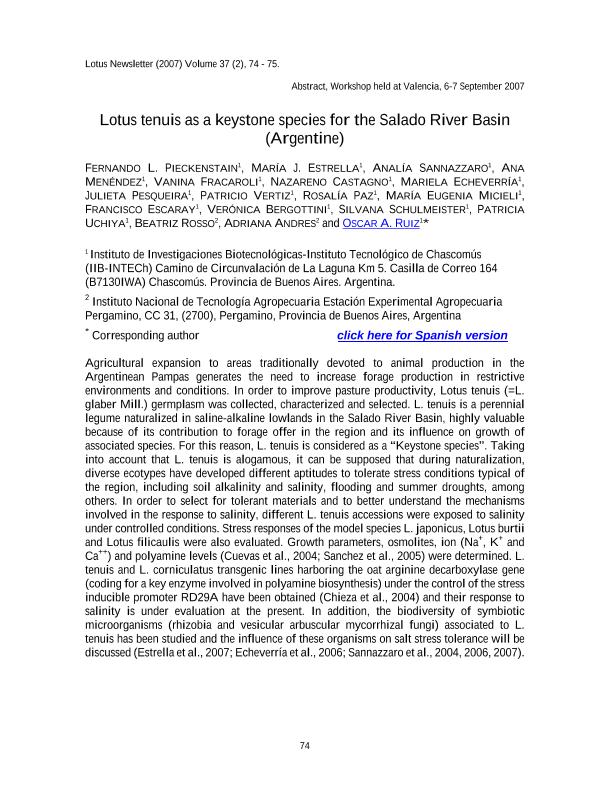Artículo
Lotus tenuis as a keystone species for the Salado River Basin (Argentine)
Pieckenstain, Fernando Luis ; Estrella, Maria Julia; Sannazzaro, Analía Inés
; Estrella, Maria Julia; Sannazzaro, Analía Inés ; Menéndez, Ana; Fracaroli, Vanina; Castagno, Luis Nazareno
; Menéndez, Ana; Fracaroli, Vanina; Castagno, Luis Nazareno ; Echeverria, Mariela
; Echeverria, Mariela ; Pesqueira, Julieta; Vértiz, Patricio
; Pesqueira, Julieta; Vértiz, Patricio ; Paz, Rosalia Cristina
; Paz, Rosalia Cristina ; Micieli, María Eugenia; Escaray, Francisco José
; Micieli, María Eugenia; Escaray, Francisco José ; Bergottini, Verónica Mariel; Schulmeister, Silvana; Uchiya, Patricia Alejandra; Rosso, Beatriz Susana; Andres, Adriana Noemí; Ruiz, Oscar Adolfo
; Bergottini, Verónica Mariel; Schulmeister, Silvana; Uchiya, Patricia Alejandra; Rosso, Beatriz Susana; Andres, Adriana Noemí; Ruiz, Oscar Adolfo
 ; Estrella, Maria Julia; Sannazzaro, Analía Inés
; Estrella, Maria Julia; Sannazzaro, Analía Inés ; Menéndez, Ana; Fracaroli, Vanina; Castagno, Luis Nazareno
; Menéndez, Ana; Fracaroli, Vanina; Castagno, Luis Nazareno ; Echeverria, Mariela
; Echeverria, Mariela ; Pesqueira, Julieta; Vértiz, Patricio
; Pesqueira, Julieta; Vértiz, Patricio ; Paz, Rosalia Cristina
; Paz, Rosalia Cristina ; Micieli, María Eugenia; Escaray, Francisco José
; Micieli, María Eugenia; Escaray, Francisco José ; Bergottini, Verónica Mariel; Schulmeister, Silvana; Uchiya, Patricia Alejandra; Rosso, Beatriz Susana; Andres, Adriana Noemí; Ruiz, Oscar Adolfo
; Bergottini, Verónica Mariel; Schulmeister, Silvana; Uchiya, Patricia Alejandra; Rosso, Beatriz Susana; Andres, Adriana Noemí; Ruiz, Oscar Adolfo
Fecha de publicación:
12/2007
Editorial:
Instituto Nacional de Investigación Agropecuaria
Revista:
Lotus Newsletter
ISSN:
1510-7809
Idioma:
Inglés
Tipo de recurso:
Artículo publicado
Clasificación temática:
Resumen
Agricultural expansion to areas traditionally devoted to animal production in the Argentinean Pampas generates the need to increase forage production in restrictive environments and conditions. In order to improve pasture productivity, Lotus tenuis (=L. glaber Mill.) germplasm was collected, characterized and selected. L. tenuis is a perennial legume naturalized in saline-alkaline lowlands in the Salado River Basin, highly valuable because of its contribution to forage offer in the region and its influence on growth of associated species. For this reason, L. tenuis is considered as a “Keystone species”. Taking into account that L. tenuis is alogamous, it can be supposed that during naturalization, diverse ecotypes have developed different aptitudes to tolerate stress conditions typical of the region, including soil alkalinity and salinity, flooding and summer droughts, among others. In order to select for tolerant materials and to better understand the mechanisms involved in the response to salinity, different L. tenuis accessions were exposed to salinity under controlled conditions. Stress responses of the model species L. japonicus, Lotus burtii and Lotus filicaulis were also evaluated. Growth parameters, osmolites, ion (Na+, K+ and Ca++) and polyamine levels (Cuevas et al., 2004; Sanchez et al., 2005) were determined. L. tenuis and L. corniculatus transgenic lines harboring the oat arginine decarboxylase gene (coding for a key enzyme involved in polyamine biosynthesis) under the control of the stress inducible promoter RD29A have been obtained (Chieza et al., 2004) and their response to salinity is under evaluation at the present. In addition, the biodiversity of symbiotic microorganisms (rhizobia and vesicular arbuscular mycorrhizal fungi) associated to L. tenuis has been studied and the influence of these organisms on salt stress tolerance will be discussed (Estrella et al., 2007; Echeverría et al., 2006; Sannazzaro et al., 2004, 2006, 2007).
Palabras clave:
Lotus tenuis
,
salinity
,
salado river basin
,
soil
Archivos asociados
Licencia
Identificadores
Colecciones
Articulos(IBAM)
Articulos de INST.DE BIOLOGIA AGRICOLA DE MENDOZA
Articulos de INST.DE BIOLOGIA AGRICOLA DE MENDOZA
Citación
Pieckenstain, Fernando Luis; Estrella, Maria Julia; Sannazzaro, Analía Inés; Menéndez, Ana; Fracaroli, Vanina; et al.; Lotus tenuis as a keystone species for the Salado River Basin (Argentine); Instituto Nacional de Investigación Agropecuaria; Lotus Newsletter; 37; 2; 12-2007; 74-75
Compartir



